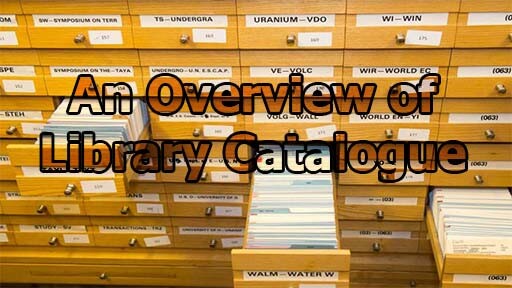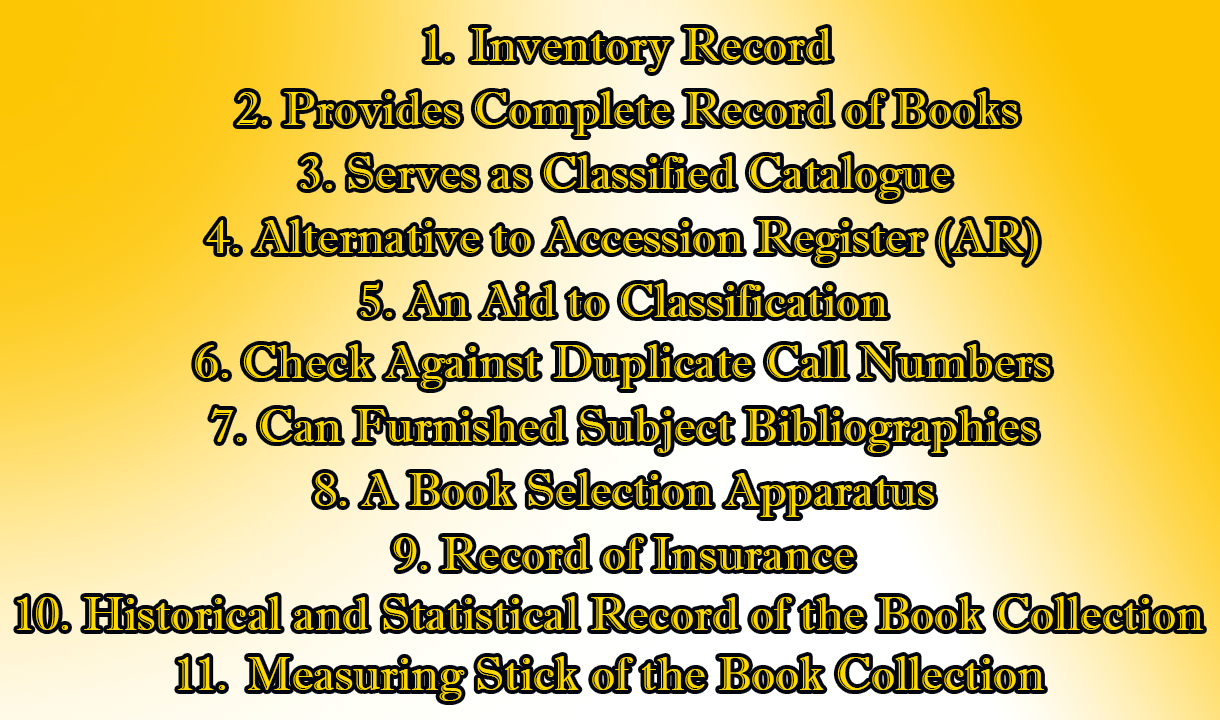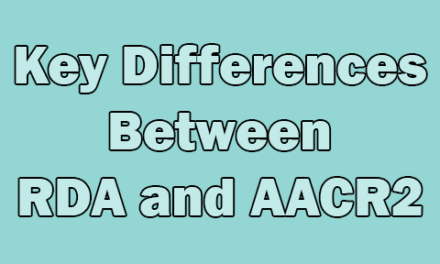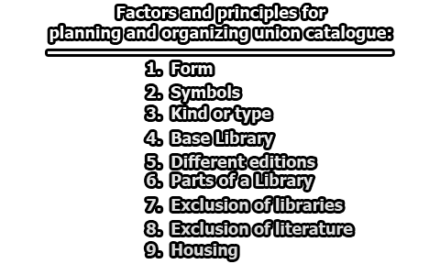An Overview of Library Catalogue:
A library catalogue is a list of materials owned by a library or group of libraries, which provides users with information about the resources available to them. The purpose of a library catalogue is to provide a means for users to find and access library materials, both physical and digital, and to provide a standardized way of describing those materials so that users can easily understand what is available to them. Library catalogues can take different forms, depending on the type of library and the materials being catalogued. In the rest of this article, we will explore an overview of library catalogue.
Basic Concepts of Catalogue and Cataloguing:
Cataloguing is the process of creating bibliographic records for books and other materials in a library’s collection, while a catalogue is a list of all the materials in a library’s collection. Here are some basic concepts of cataloguing and catalogues in libraries:
- Authority control: Authority control is the process of ensuring that all variations of an author’s name, subject headings, and other fields are consistent and correctly spelt in the library catalogue. This helps to prevent duplicate records and makes it easier for users to find materials.
- Catalogue record: A catalogue record is a bibliographic description of a library item, including information such as the author, title, publication date, and call number. Catalogue records follow established rules and standards, such as the Anglo-American Cataloguing Rules (AACR2) or the Resource Description and Access (RDA) standards.
- Call number: A call number is a unique identifier assigned to each item in a library’s collection, based on its subject matter and classification scheme. Call numbers help to organize materials on library shelves and make it easier for users to find specific items.
- Controlled vocabulary: Controlled vocabulary is a list of approved subject headings or terms that are used to describe the content of library materials consistently. This ensures that materials on the same subject are grouped together in the catalogue.
- MARC format: The MARC (Machine-Readable Cataloguing) format is a standard format used for cataloguing records. MARC records include fields for bibliographic information such as title, author, publisher, and publication date, as well as fields for cataloguing information such as call number and subject headings.
- Online Public Access Catalogue (OPAC): An OPAC is a computerized catalogue that allows library users to search for materials in the library’s collection. OPACs provide users with information about the availability, location, and other details of materials in the library.
So, cataloguing and catalogues are essential components of library organization, helping to ensure that materials are described accurately and can be easily found by library users.
Definitions of a Good Catalogue:
There are several definitions are provided by different writers which are not equally important. Some of the necessary definitions are given below:
“A good catalogue is one that enables a person to find a book of which the author, title, or subject is known; or to find all the books on a given subject in a given library.” – (Charles Cutter)
“A good catalogue is one that is able to convey to the users the contents of a library collection in a systematic and logical manner, and enables them to locate the documents of their interest quickly and efficiently.” – (S.R. Ranganathan)
“A good catalogue is one that reflects the library’s collection in a clear, accurate, and comprehensive manner, while also being easy to use and accessible to a variety of users.” – (Michael Gorman)
“A good catalogue is one that is designed to meet the needs of its users, with an emphasis on clarity, consistency, and accuracy.” – (Barbara Tillett)
From the above definitions, we can say that a good catalogue should be able to help users find what they are looking for quickly and efficiently, provide a comprehensive overview of the library’s collection, be accurate and accessible, and be designed to the needs of its users in mind.
Objectives and Purposes of a Good Catalogue:
A good catalogue serves several objectives and purposes in a library. The main objective is to provide access to the library’s collection and to help users find the items they need quickly and efficiently. In this article, we will discuss the objectives and purposes of a good catalogue in detail.
- To provide access to the library’s collection: A good catalogue serves as a tool for users to access the library’s collection. It provides information about the items available in the library, including books, journals, audio recordings, and other materials. By using the catalogue, users can search for specific items and locate them in the library.
- To help users find items quickly and efficiently: A good catalogue helps users find items quickly and efficiently. It allows users to search for items by author, title, subject, and keyword. This makes it easier for users to locate items that meet their specific needs.
- To organize the collection: A good catalogue helps to organize the library’s collection in a logical and systematic manner. It uses a classification system to group items by subject, which makes it easier for users to find related items. The catalogue also helps to ensure that items are shelved in the correct location.
- To provide information about items: A good catalogue provides information about the items available in the library. This includes the author, title, publisher, date of publication, and subject headings. This information helps users to select items that meet their needs.
- To assist in collection development: A good catalogue assists in collection development by providing information about the library’s collection. It helps librarians to identify areas where the collection may need to be strengthened or expanded. By analyzing the catalogue data, librarians can make informed decisions about which items to acquire for the library.
- To provide data for library statistics: A good catalogue provides data that can be used to generate library statistics. This includes information about the number of items in the collection, the number of items circulated, and the types of items used most frequently. This data can be used to assess the library’s performance and to plan for future development.
- To improve user satisfaction: A good catalogue improves user satisfaction by making it easier for users to find the items they need. By providing accurate and comprehensive information about the library’s collection, the catalogue helps users to make informed decisions about which items to select.
A good catalogue serves several important objectives and purposes in a library. It provides access to the library’s collection, helps users find items quickly and efficiently, organizes the collection, provides information about items, assists in collection development, provides data for library statistics, and improves user satisfaction. By fulfilling these objectives and purposes, a good catalogue plays a vital role in the overall success of the library.
Functions and Characteristics of a Good Catalogue:
A catalogue is a list of all the materials in a library’s collection, and it serves as an essential tool for helping users locate and access those materials. The followings are some functions and characteristics of a good catalogue for a library:
- Comprehensive: A good catalogue should include all the materials in the library’s collection, including books, periodicals, audiovisual materials, and other items.
- Accurate: Catalogue entries should be accurate and reflect the content of the materials they describe. This includes correct titles, authors, subject headings, and other descriptive information.
- Consistent: Catalogue entries should be consistent in their format and content, following established rules and standards such as AACR2 or RDA.
- Accessible: The catalogue should be easily accessible to library users, either through an online catalogue or a physical catalogue located in the library. The catalogue should be user-friendly, with clear search options and intuitive navigation.
- Up-to-date: The catalogue should be regularly updated to reflect additions and deletions to the library’s collection. This includes adding new materials and removing materials that are no longer part of the collection.
- Browsable: The catalogue should allow users to browse by subject, author, and other categories to discover materials they may not have been specifically looking for.
- Searchable: The catalogue should have a powerful search function that allows users to find materials quickly and easily using keywords, titles, authors, and other criteria.
- Clear display of information: A good catalogue should display catalogue entries in a clear and organized manner. Information should be presented in a consistent format and in a way that is easy to read and understand.
- Cross-referencing: The catalogue should have cross-referencing capabilities to help users find related materials. For example, a book on a specific topic might have cross-references to other books on the same topic or related subjects.
- Multilingual capabilities: In libraries that serve communities speaking different languages, a good catalogue should have multilingual capabilities to provide access to materials in languages other than the primary language of the library.
- Availability information: The catalogue should provide information about the availability of materials, including whether they are checked out or available for checkout, and the location of the item in the library.
- Holdings information: The catalogue should provide information about the library’s holdings of a specific title, including different editions, formats, and translations.
- Advanced search capabilities: The catalogue should provide advanced search capabilities to allow users to refine their search results and find materials more easily. This might include options to search by publication date, author, or specific subject terms.
- Linked data: A good catalogue should be linked to other systems or databases, such as authority files, subject vocabularies, or interlibrary loan systems, to provide users with access to additional information and resources.
- Customization options: The catalogue should allow users to customize their search preferences and create personal accounts to save lists of materials or receive notifications when new materials are added to the library’s collection.
Overall, a good catalogue for a library should provide accurate, comprehensive, and easily accessible information about the library’s collection and should be designed to meet the needs of diverse user groups.
Outer and Inner Forms of Catalogues:
The outer and inner forms of a catalogue refer to the physical structure and organization of the catalogue. The following are explanations of each type:
- Outer Form: The outer form of a catalogue refers to the physical structure and design of the catalogue. This includes the cover or binding, the size and shape of the catalogue, and any visual or graphic elements that are included to help users identify the catalogue. The outer form of a catalogue can be either printed or digital, depending on the format of the catalogue.
- Inner Form: The inner form of a catalogue refers to the organization and structure of the catalogue’s entries. This includes the arrangement of the entries, the descriptive information included for each item, and any indexing or cross-referencing features that are included to help users find materials in the catalogue. The inner form of a catalogue can also be either printed or digital.
There are several types of inner forms for catalogues used in libraries:
a. Alphabetical Catalogue: This type of catalogue arranges entries alphabetically by author, title, or subject. Entries are typically listed in a single, continuous alphabetical sequence.
b. Classified Catalogue: This type of catalogue arranges entries according to a classification system, such as the Dewey Decimal Classification or Library of Congress Classification. Entries are grouped together by subject, with subcategories and subdivisions used to further refine the organization of entries.
c. Dictionary Catalogue: This type of catalogue arranges entries alphabetically by author, title, or subject, but also includes a comprehensive index that allows users to search for entries by any keyword or phrase.
d. Shelflist Catalogue: This type of catalogue is a physical record of the library’s holdings, listing items in call number order by location on the library shelves.
e. Online Catalogue: This type of catalogue is accessed through a computer or mobile device, allowing users to search and browse the library’s collection online. Online catalogues can be designed to mimic the structure of any of the above inner forms.
The inner and outer forms of a catalogue work together to provide users with a clear and organized representation of the library’s collection, making it easier for users to find the materials they need.
It is apparent that a library catalogue is an essential tool for users of a library, providing them with access to the resources available in the library’s collection. Cataloguing is the process of creating and maintaining a catalogue and has evolved over time to include computerized systems that allow for greater access and flexibility in searching and browsing library resources.

Library Lecturer at Nurul Amin Degree College










